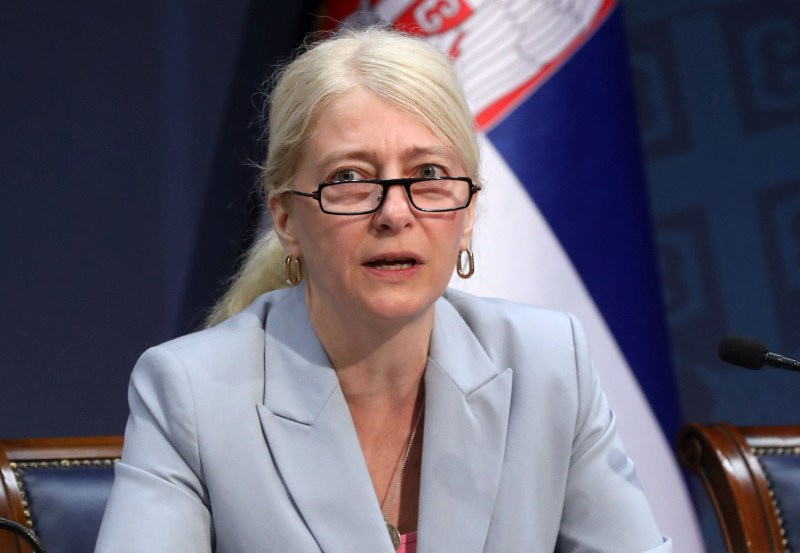- Serbia
Get to know Serbia
- Citizens
Culture and science
Health services
Pension and disability insurance
- Business
Employment
Economy
- Media
- Government
- Contact
Keep in touch
Contact form
Back
Keepin touch
Whether you have a question, comment, suggestion or any problem in the purview of the government, send us your message and we will try to respond as soon as possible. If your problem is not in our purview, we will forward your message to the relevant institution.
Q:
A:
57th session of WHO Regional Committee ends
Belgrade,
20 September 2007
Serbian Minister of Health Tomica Milosavljevic stressed today that obesity which directly causes two thirds of diseases is a global problem, and added that this subject was especially examined at the three-day session of the WHO Regional Committee for Europe.
Speaking at a press conference held at the end of the 57th session of the WHO Regional Committee, Milosavljevic pointed out problems faced by obese people, and specified that some 25% to 30% of people in Serbia are obese, and 18% are overweight.
WHO Regional Director for Europe Marc Danzon warned that the global child mortality rate is still high, and inadequate health facilities are a huge obstacle in realising WHO goals.
Danzon explained that there are huge differences between the East and West in the WHO European region, so that the mortality rate of children younger than five years in certain countries is 40% more than in other countries.
According to Danzon, there are huge differences also between different areas within countries, so that not a single country fulfills WHO goals which relate to child mortality rate.
He recalled that the Millennium Development Goals (MDGs), which are focused on the health of mother and child, were agreed upon in 2000, concern the fight against non-infectious diseases and other key issues which concern public health.
Danzon stressed that national plans for health workers are needed which could increase direct investment in training of future employees in the health sector, while providing present workers an opportunity to develop their careers.
At the 57th session of the WHO Regional Committee the six-year Plan for Food and Nutrition Policy was adopted, which demands reduction in intake of fat and sugar by 10% and reduction of salt intake by five grams daily.
The problems of migration of health employees and the realisation of MDGs by 2015 were also discussed at the session.
The WHO, whose seat is in Geneva, is divided into six regional offices – Africa, USA, East Mediterranean, South East Asia, West Pacific and Europe.
The WHO Regional Committee holds session once every year, and the meeting for the upcoming year will take place in Tbilisi, Georgia.
WHO Regional Director for Europe Marc Danzon warned that the global child mortality rate is still high, and inadequate health facilities are a huge obstacle in realising WHO goals.
Danzon explained that there are huge differences between the East and West in the WHO European region, so that the mortality rate of children younger than five years in certain countries is 40% more than in other countries.
According to Danzon, there are huge differences also between different areas within countries, so that not a single country fulfills WHO goals which relate to child mortality rate.
He recalled that the Millennium Development Goals (MDGs), which are focused on the health of mother and child, were agreed upon in 2000, concern the fight against non-infectious diseases and other key issues which concern public health.
Danzon stressed that national plans for health workers are needed which could increase direct investment in training of future employees in the health sector, while providing present workers an opportunity to develop their careers.
At the 57th session of the WHO Regional Committee the six-year Plan for Food and Nutrition Policy was adopted, which demands reduction in intake of fat and sugar by 10% and reduction of salt intake by five grams daily.
The problems of migration of health employees and the realisation of MDGs by 2015 were also discussed at the session.
The WHO, whose seat is in Geneva, is divided into six regional offices – Africa, USA, East Mediterranean, South East Asia, West Pacific and Europe.
The WHO Regional Committee holds session once every year, and the meeting for the upcoming year will take place in Tbilisi, Georgia.
-
 Belgrade, 22 January 2025
Belgrade, 22 January 2025Egypt one of Serbia’s closest partners on international stage
-
 Belgrade, 9 July 2024
Belgrade, 9 July 2024Support for 104 associations in diaspora that preserve Serbian language, culture
-
 Belgrade, 15 April 2024
Belgrade, 15 April 2024Competition for StarTech grants open until 31 May
-
 Belgrade, 2 October 2023
Belgrade, 2 October 2023Serbia respects Resolution 1244 and will do everything to preserve peace
-
 Belgrade, 13 September 2023
Belgrade, 13 September 2023Day of Serbian Unity to be celebrated outside borders of Serbia, Republika Srpska for the first time
-
 Belgrade, 8 August 2023
Belgrade, 8 August 2023RSD 24.2m in state aid paid out to citizens affected by storm
-
 Belgrade, 17 June 2023
Belgrade, 17 June 2023Belgrade is doing everything to preserve peace in Kosovo and Metohija
-
 Belgrade, 15 June 2023
Belgrade, 15 June 2023Slovenia will continue to support Serbia on its way to EU
-
 Belgrade, 5 May 2023
Belgrade, 5 May 2023Emergency measures, tightening of conditions for possessing weapons
-
 Belgrade, 3 May 2023
Belgrade, 3 May 2023Three days of mourning in Serbia over tragedy at Vladislav Ribnikar primary school

